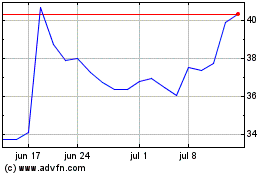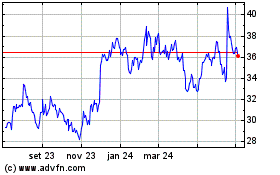U.S. index futures showed moderate changes in pre-market trading
on Tuesday after the S&P 500 and Nasdaq Composite achieved
their longest winning streaks in 2024. Market volatility has
decreased, and investors are awaiting the Jackson Hole Economic
Symposium for potential hints about future interest rate cuts.
At 5:00 AM ET, Dow Jones futures (DOWI:DJI) were up 12 points,
or 0.03%. S&P 500 futures gained 0.06%, and Nasdaq-100 futures
rose 0.10%. The 10-year Treasury yield stood at 3.867%.
In commodities, oil prices fell after Israel accepted a
ceasefire proposal for Gaza, easing concerns about supply
disruptions. Additionally, increased oil production in Libya and
weak demand data from China put downward pressure on prices.
West Texas Intermediate crude for September dropped 1.17% to
$73.50 per barrel, while Brent for October declined 0.63% to $77.17
per barrel.
Iron ore prices are expected to fall to around $80 per ton due
to reduced steel production in China, according to Citigroup.
Analysts indicate the market is imbalanced, and prices below $100,
previously attractive for purchases, now reflect different
dynamics, with lower steel demand in China. Reduced demand and
increased exports have created a market surplus. The bank revised
its price forecast from $95 to $85 per ton.
Gold surpassed the $2,500 per ounce record, driven by
expectations of Federal Reserve interest rate cuts. The 21%
increase year-to-date makes gold one of the best-performing
commodities of 2024. Analysts from UBS Group AG and ANZ Group
Holdings expect the price to reach $2,700 by mid-2025, supported by
central bank purchases and demand for hedges.
Tuesday’s U.S. economic calendar includes two key speeches that
could influence market perceptions of U.S. monetary policy. At 1:35
PM ET, Atlanta Fed President Raphael Bostic will speak. Later, at
2:45 PM ET, Fed Vice Chair for Supervision Michael Barr will also
deliver remarks.
Asia-Pacific markets had mixed results on Tuesday. Japan’s
Nikkei 225 advanced 1.8%, driven by utility and healthcare stocks.
South Korea’s Kospi rose 0.83%, while Australia’s S&P/ASX 200
edged up 0.22%. In contrast, China’s CSI 300 fell 0.72%, and Hong
Kong’s Hang Seng Index was down 0.50% in late trading.
In China, new home prices are plummeting in cities like Beijing
and Shenzhen, with cuts of up to 29%. This decline is attributed to
reduced government controls and efforts to correct market
distortions while trying to stimulate demand amid the property
crisis.
China’s property developer Kaisa Group Holdings has reached a
restructuring deal with a major creditor involving the issuance of
new bonds, potentially exceeding $10 billion. The company will use
these bonds to partially pay off its debts and avoid liquidation.
The agreement includes the issuance of convertible bonds, which can
be converted into company shares in the future.
In August, Chinese banks kept interest rates unchanged, with the
one-year loan rate at 3.35% and the five-year rate at 3.85%.
Keeping rates steady reflects concerns over banks’ profit margins
after last month’s rate cuts to boost the economy. This comes as
the People’s Bank of China (PBOC) seeks to balance economic growth
and financial health, avoiding drastic cuts. Further reductions are
expected if the Federal Reserve cuts rates in September.
The Reserve Bank of Australia (RBA) decided to keep interest
rates at 4.35%, considering high inflation and market recovery.
While it debated a possible hike, it opted not to cut rates in the
short term and may maintain restrictive policy for longer,
rejecting expectations of cuts in December, according to minutes
from the August 5-6 board meeting released on Tuesday.
According to a Reuters poll, the Bank of Korea will keep the
interest rate at 3.50% on Thursday. High inflation and the won’s
depreciation are expected to limit immediate cuts, with a possible
reduction to 3.25% by year-end.
European markets are mostly up, with sectors showing mixed
performance as investors await German producer price index data and
the final annual inflation rate for the EU. In Sweden, the Riksbank
cut interest rates by 25 basis points from 3.75% to 3.50% and
signaled two or three more rate cuts this year. Among individual
stocks, Zealand Pharma AS (TG:22Z) saw its shares rise nearly 4%
after news about seeking a pharmaceutical partner.
U.S. stocks rose on Monday, boosted by economic data that
increased expectations of Federal Reserve interest rate cuts. The
Nasdaq and S&P 500 posted their eighth consecutive gains. The
Dow Jones added 0.58% to 40,896.53, the S&P 500 climbed 0.97%
to 5,608.26, and the Nasdaq advanced 1.39% to 17,876.77.
The chances of a Federal Reserve rate cut next month have risen
significantly, with the CME Group’s FedWatch tool indicating a
75.5% probability of a 0.25 percentage point cut. Additionally,
there’s a 24.5% chance of a more aggressive 0.5 percentage point
cut.
On the earnings front, pre-market reports are expected from
Lowe’s (NYSE:LOW), Medtronic (NYSE:MDT), Vip.com (NYSE:VIPS), Workhorse
Group (NASDAQ:WKHS), NANO-X
Imaging (NASDAQ:NNOX), XPeng (NYSE:XPEV), H
World Group (NASDAQ:HTHT), Kingsway
Cloud (NASDAQ:KC), Navios Maritime
Partners (NYSE:NMM), Futu
Holdings (NASDAQ:FUTU), among others.
After the close, reports are expected from Toll
Brothers (NYSE:TOL), PagSeguro (NYSE:PAGS), Jack
Henry &
Associates (NASDAQ:JKHY), La-Z-Boy (NYSE:LZB), DADA
Nexus (NASDAQ:DADA), Keysight
Technologies (NYSE:KEYS), Coty (NYSE:COTY), ZTO
Express (NYSE:ZTO), Emeren
Group (NYSE:SOL), Sociedad Quimica y
Minera de Chile (NYSE:SQM), and more.
La Z Boy (NYSE:LZB)
Gráfico Histórico do Ativo
De Jul 2024 até Ago 2024

La Z Boy (NYSE:LZB)
Gráfico Histórico do Ativo
De Ago 2023 até Ago 2024
